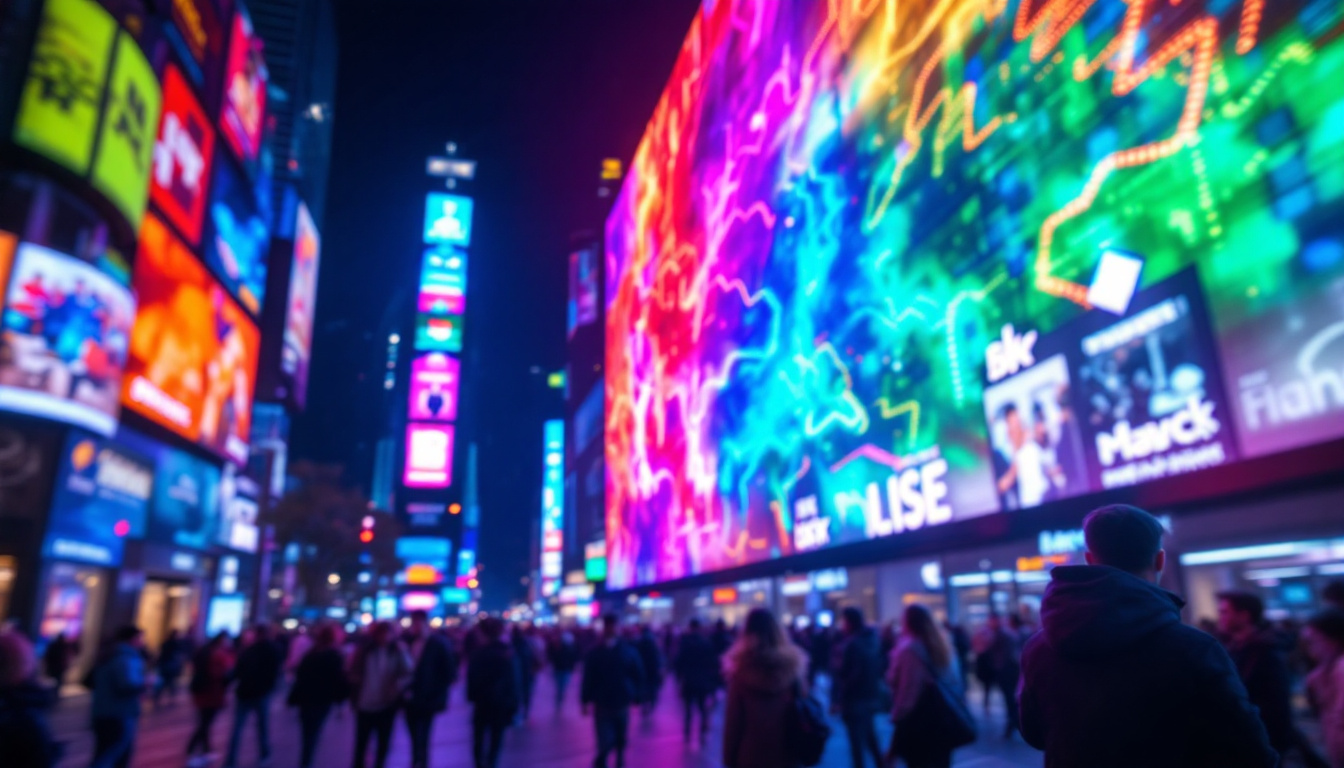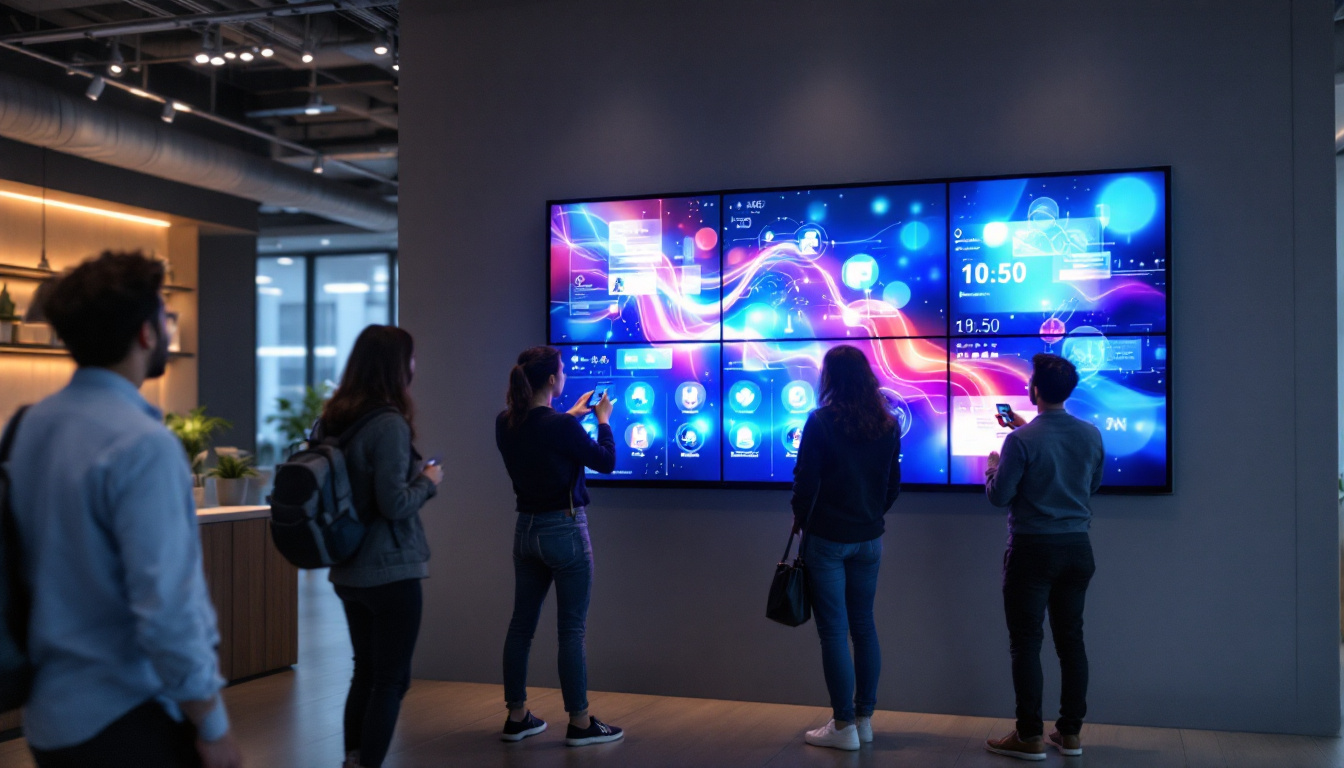In the age of digital transformation, businesses and organizations are continually seeking innovative ways to engage their audiences. One of the most captivating technologies that have emerged in recent years is the interactive digital wall, often powered by LED displays. This article delves into the intricacies of interactive digital walls, exploring their components, functionalities, applications, and future trends.
“`html
Understanding Interactive Digital Walls
Interactive digital walls are large-scale displays that allow users to interact with content in real-time. Unlike traditional displays, these walls incorporate touch-sensitive technology, enabling a dynamic user experience. They can be utilized in various environments, from corporate offices to public spaces, enhancing communication and engagement.
What is an LED Display?
LED, or Light Emitting Diode, displays are a type of flat panel display that utilizes LEDs as pixels for producing images. These displays are known for their brightness, energy efficiency, and versatility. They can be configured in various sizes and resolutions, making them suitable for both indoor and outdoor applications.
The technology behind LED displays has evolved significantly, leading to the development of high-resolution screens that can produce vibrant colors and sharp images. This advancement has made LED displays the preferred choice for interactive digital walls, as they can effectively capture and hold the attention of viewers. Furthermore, the durability of LED technology ensures that these displays can withstand varying environmental conditions, making them ideal for outdoor advertising and public installations.
Key Components of Interactive Digital Walls
To fully appreciate the capabilities of interactive digital walls, it is essential to understand their key components. These include:
- Display Panels: The backbone of any interactive digital wall, these panels are often made of multiple LED screens that can be tiled together to create a seamless visual experience.
- Touch Technology: Various technologies, such as capacitive or infrared touch, enable users to interact with the display. This interaction can range from simple touch gestures to complex multi-touch functionalities.
- Content Management System (CMS): A robust CMS allows users to create, manage, and display content on the wall efficiently. This software is crucial for ensuring that the content remains fresh and engaging.
- Sensors and Cameras: These components can enhance interactivity by detecting user movements or gestures, allowing for a more immersive experience.
How Do Interactive Digital Walls Work?
The functionality of interactive digital walls hinges on the integration of hardware and software. The LED panels display high-quality visuals, while the touch technology enables user interaction. When a user touches the screen, the system registers the input and responds accordingly, whether it be navigating through a presentation or engaging with interactive content.
Moreover, the CMS plays a pivotal role in managing the content displayed on these walls. It allows for real-time updates, ensuring that the information presented is always relevant. The combination of these elements creates a fluid and engaging experience that captivates audiences. In addition, the ability to integrate multimedia elements such as videos, animations, and live data feeds further enhances the interactive nature of these walls, making them a powerful tool for storytelling and information dissemination. As organizations continue to seek innovative ways to connect with their audiences, the applications of interactive digital walls are expanding, paving the way for more creative and impactful communication strategies.
“`
Applications of Interactive Digital Walls
Interactive digital walls have found applications across a myriad of sectors, each leveraging this technology to enhance user engagement and communication. Here are some notable examples:
Corporate Environments
In corporate settings, interactive digital walls serve as powerful tools for presentations, brainstorming sessions, and collaborative work. They allow teams to visualize data, share ideas, and engage in real-time discussions. The ability to manipulate content directly on the screen fosters a more interactive and productive meeting atmosphere.
Additionally, these walls can be used for digital signage, displaying important announcements or information to employees and visitors alike. This capability enhances internal communication and ensures that everyone remains informed. Moreover, the integration of analytics tools can provide insights into employee engagement and information retention, allowing companies to tailor their communications for maximum impact.
Education and Training
Educational institutions are increasingly adopting interactive digital walls to create immersive learning environments. These displays can transform traditional classrooms into interactive learning hubs, where students can engage with educational content in a hands-on manner.
Interactive digital walls facilitate collaborative learning, allowing students to work together on projects and presentations. This technology can also be utilized for training sessions, where participants can interact with simulations and real-time data, enhancing the learning experience. Furthermore, educators can use these walls to incorporate multimedia resources, such as videos and interactive quizzes, which cater to various learning styles and keep students engaged throughout the lesson.
Public Spaces and Events
In public spaces, interactive digital walls are used to engage visitors and provide information. Museums, galleries, and exhibitions utilize these displays to create interactive exhibits that encourage exploration and learning. Visitors can engage with the content, making their experience more memorable.
During events, such as trade shows or conferences, interactive digital walls can serve as focal points, drawing attendees in with dynamic content and interactive features. This not only enhances the overall experience but also increases brand visibility and engagement. Additionally, these walls can be programmed to collect visitor data, allowing organizations to analyze foot traffic patterns and preferences, which can inform future event planning and marketing strategies. By integrating social media feeds or live polls, event organizers can further amplify audience interaction, creating a vibrant atmosphere that resonates with attendees long after the event has concluded.
Benefits of Interactive Digital Walls
The adoption of interactive digital walls comes with a multitude of benefits that can significantly impact user engagement and communication effectiveness. Here are some of the key advantages:
Enhanced Engagement
One of the most significant benefits of interactive digital walls is their ability to captivate audiences. The combination of high-quality visuals and interactive features draws users in, encouraging them to engage with the content actively. This heightened level of engagement can lead to better retention of information and a more impactful experience.
Flexibility and Adaptability
Interactive digital walls are highly versatile, allowing for various content types, including videos, images, and interactive applications. This flexibility enables organizations to tailor their content to suit different audiences and contexts. Whether it’s a corporate presentation or an educational exhibit, interactive digital walls can adapt to meet specific needs.
Real-Time Updates
With a robust content management system, organizations can update the content displayed on interactive digital walls in real-time. This capability ensures that information is always current and relevant, which is particularly important in fast-paced environments. It also allows for the quick dissemination of important announcements or changes.
Challenges and Considerations
While interactive digital walls offer numerous benefits, there are also challenges and considerations that organizations must address before implementation. Understanding these factors can help ensure a successful deployment.
Cost Implications
The initial investment for interactive digital walls can be substantial, encompassing the cost of hardware, software, and installation. Organizations must weigh the potential return on investment against these costs. However, it is essential to consider the long-term benefits and enhanced engagement that these displays can provide.
Technical Expertise
Implementing and maintaining interactive digital walls requires a certain level of technical expertise. Organizations may need to invest in training staff or hiring specialists to manage the system effectively. Ensuring that the technology is utilized to its full potential is crucial for maximizing its impact.
Content Creation and Management
Creating engaging and relevant content for interactive digital walls is an ongoing challenge. Organizations must allocate resources to develop high-quality visuals and interactive applications that resonate with their audiences. A well-planned content strategy is essential for maintaining engagement over time.
Future Trends in Interactive Digital Walls
The landscape of interactive digital walls is continually evolving, driven by advancements in technology and changing user expectations. Here are some trends to watch for in the future:
Integration with Augmented Reality (AR)
As AR technology becomes more accessible, its integration with interactive digital walls is likely to increase. This combination can create immersive experiences that blend the physical and digital worlds, allowing users to interact with content in unprecedented ways. AR can enhance storytelling and engagement, making it a powerful tool for various applications.
Artificial Intelligence (AI) Enhancements
AI is poised to play a significant role in the future of interactive digital walls. From personalized content recommendations to advanced analytics, AI can enhance user experiences and streamline content management. By analyzing user interactions, AI can help organizations tailor their content to meet the specific needs and preferences of their audiences.
Sustainability and Eco-Friendly Solutions
As environmental concerns grow, there is a push for sustainable technology solutions. Future interactive digital walls may incorporate eco-friendly materials and energy-efficient technologies. Organizations that prioritize sustainability will not only benefit the environment but also appeal to increasingly eco-conscious consumers.
Conclusion
Interactive digital walls represent a significant advancement in communication and engagement technology. Their ability to captivate audiences through dynamic visuals and interactive features makes them invaluable tools for various applications, from corporate environments to public spaces. While challenges exist, the benefits of enhanced engagement, flexibility, and real-time updates make them a worthy investment.
As technology continues to evolve, the future of interactive digital walls looks promising. With the integration of AR, AI, and sustainable practices, organizations can expect even more innovative solutions that will redefine how they connect with their audiences. Embracing this technology now can position businesses and institutions at the forefront of digital transformation, paving the way for a more interactive and engaging future.
“`html
Discover LumenMatrix LED Display Solutions
Ready to elevate your space with the next level of interactive digital walls? LumenMatrix, a pioneer in LED display technology, offers a comprehensive range of solutions tailored to bring your visual communication to life. From mesmerizing Indoor and Outdoor LED Wall Displays to innovative options like Vehicle, Sports, and Floor LED Displays, our products are designed to captivate your audience and amplify your message. Experience the future of engagement with our Custom, All-in-One, and Transparent LED Displays. Check out LumenMatrix LED Display Solutions today and transform your environment into an interactive digital masterpiece.
“`































